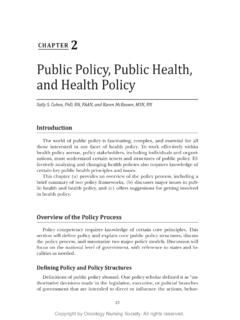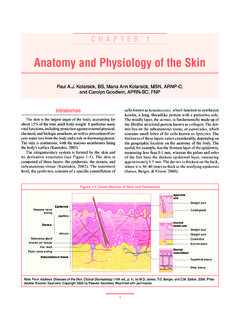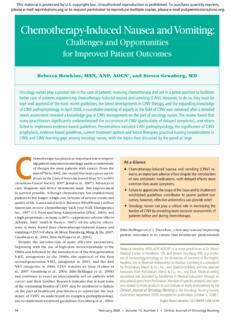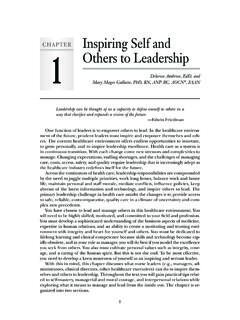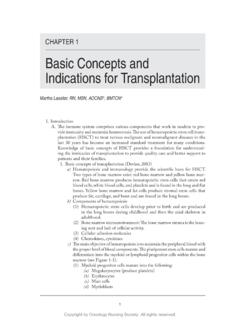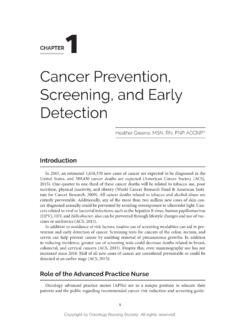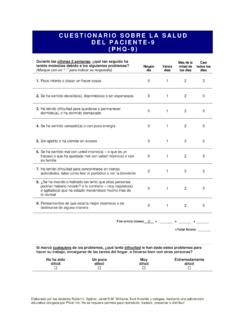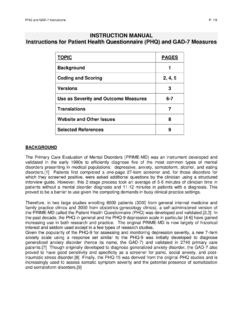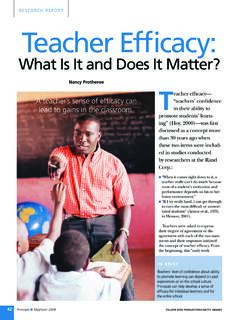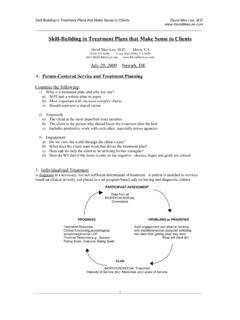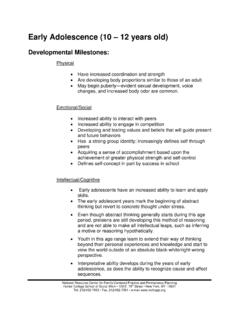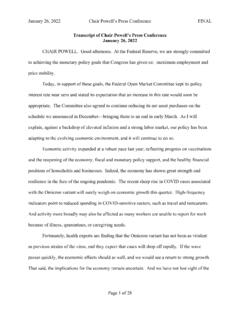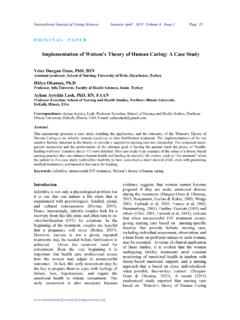Transcription of The Psychosocial Impact of Cancer on the Individual ...
1 3 CHAPTER 1 The < strong >Psychosocialstrong > < strong >Impactstrong > of < strong >Cancerstrong > on the < strong >Individualstrong > , Family, and SocietyLINDA M. GORMAN, RN, MN, APRN, BC, OCN , CHPNWe are not ourselves when nature, being oppressed, commands the mind to suffer with the body. William ShakespeareIt is now known that < strong >Psychosocialstrong > issues affect patients in all stages of < strong >Cancerstrong > . Emotional response can infl uence both morbidity and mortality (Holland, 2002). The increased emphasis on < strong >Psychosocialstrong > oncology in recent years has led to more research, education, and training programs as more professionals appreciate the importance of this aspect of care.
2 < strong >Psychosocialstrong > care of patients is needed in all phases of the < strong >Cancerstrong > experience. Holland (2003) identifi ed three factors contributing to psychological adaptation: (a) type of < strong >Cancerstrong > , (b) personal coping skills, and (c) society s prevailing attitudes toward anxiety and uncertainty of a < strong >Cancerstrong > diagnosis can create extreme disruption in the life of almost any < strong >Individualstrong > . A < strong >Cancerstrong > diagnosis can create a threat to one s general sense of security and orderliness in life. Although the vast majority of cancers are treatable, many people retain deep-seated fears that any < strong >Cancerstrong > represents pain, suffering, and death.
3 Holland (2002) noted that no disease has sustained as strong of a negative stigma as < strong >Cancerstrong > . These fears can contribute to a person s reaction to a new < strong >Cancerstrong > diagnosis. Whatever the type of < strong >Cancerstrong > , people are faced with ongoing uncertainty about their future as they deal with the potential for an unpredictable course (Dankert et al., 2003). A < strong >Cancerstrong > diagnosis leads to a complex set of issues, including dealing with physical symptoms from the disease and treatment, facing Copyright by Oncology Nursing Society. All rights I - The < strong >Psychosocialstrong > < strong >Impactstrong > of < strong >Cancerstrong > on the < strong >Individualstrong > , Family, and Societythe existential dimension of the illness, and seeking a comforting philosophical, spiritual, or religious belief structure or values that give meaning to life and death (Holland, 2002).
4 AwarenessPrior to the diagnosis, the < strong >Individualstrong > may be aware of body changes that could indi-cate < strong >Cancerstrong > ( , a lump, abnormal bleeding). Nail (2001) called this the Recognition Phase. This awareness creates a state of hyperalertness that eventually leads to action in most people. How quickly this action occurs depends on many variables, including past experience with < strong >Cancerstrong > in oneself or one s family. An experience with < strong >Cancerstrong > may encourage some to seek quick medical attention. The experience of others may cause them to avoid medical attention because they are fearful of what the symptoms could mean.
5 Pain or discomfort created by the symptoms tends to motivate people to seek medical attention (Mood, 1996). Other factors may contribute to delays, such as feeling uncomfortable around healthcare providers, fi nancial considerations, fear of dependency, and fear of disfi gurement. Fear of < strong >Cancerstrong > treatment may contribute to an < strong >Individualstrong > s acknowledgment of symptoms. Family members with similar values may inadvertently promote the same delaying behaviors that the patient is using. Lack of knowledge about symptoms also may cause a delay. Receiving the < strong >Cancerstrong > DiagnosisIn the United States, adherence to the ethical principle of autonomy has resulted in physicians directly telling patients about the diagnosis of < strong >Cancerstrong > .
6 The principle of autonomy dictates that the < strong >Individualstrong > has the right to determine his or her own course of action with a self-determined plan (Beauchamp & Childress, 2001). In the healthcare fi eld, this means one has the right to know and participate in all healthcare decisions. The original 1847 Code of Ethics of the American Medical Association (cited in Katz, 1984) noted that a physician s duty is to avoid all things that could discourage or depress the spirit. This philosophy contributed to physi-cians receiving limited education in medical school about how to deliver bad news (Girgis & Sanson-Fisher, 1995).
7 In 1961, 90% of surveyed physicians preferred not to directly tell patients about a < strong >Cancerstrong > diagnosis (Oken, 1961). In 1977, more than 90% of physicians favored sharing such information with patients (Novack, Plumer, & Smith, 1978). This dramatic change in practice refl ected the social changes of the 1960s and 1970s that resulted in an emphasis on openness. Access to oncology specialists who had experience in sharing bad news became widely available during that time. The development of research protocols emphasizing informed consent was another factor (Holland, 2002).At times, families still ask that patients not be told about the diagnosis.
8 This creates ethical dilemmas for healthcare providers about obtaining informed consent for treat-ment from their patients. Being pressured to use words like growth for the < strong >Cancerstrong > or special medicine for chemotherapy makes providing care to these patients more diffi cult. Dunn, Patterson, and Butow (1993) noted that not being open about the diagnosis still leads to patients suspecting it and thinking that the < strong >Cancerstrong > must be so horrible that even physicians or nurses will not acknowledge it. Avoiding the use of the word < strong >Cancerstrong > reinforces the fear associated with the word (Holland, 2002, 2003).
9 Copyright by Oncology Nursing Society. All rights 1. The < strong >Psychosocialstrong > < strong >Impactstrong > of < strong >Cancerstrong > on the < strong >Individualstrong > , Family, and SocietyIf physicians do not tell patients the diagnosis, a risk always exists that someone will inadvertently share the information with the patient, causing the patient to greatly distrust the healthcare team and family. Dunn et al. (1993) identifi ed the tendency of healthcare professionals and family members to avoid patients who have not been told the truth because of the fear of misspeaking. Openness about the diagnosis and prog-nosis enables patients to think more realistically about their condition and participate actively in treatment planning.
10 Most individuals are able to adjust to the diagnosis over time (Dunn et al.). It is important to note that autonomy is not practiced worldwide. Patients and families from other cultures may be unprepared to receive the diagnosis directly. Healthcare professionals need to address the family s fears about sharing the news and offer suggestions for assisting the patient. Creating a balance between provid-ing some information without alienating the patient and family can be diffi cult. How one receives news of a < strong >Cancerstrong > diagnosis is an important factor in how one responds (Dias, Chabner, Lynch, & Penson, 2003; Rabow & McPhee, 1999; Tulsky, 1998).
